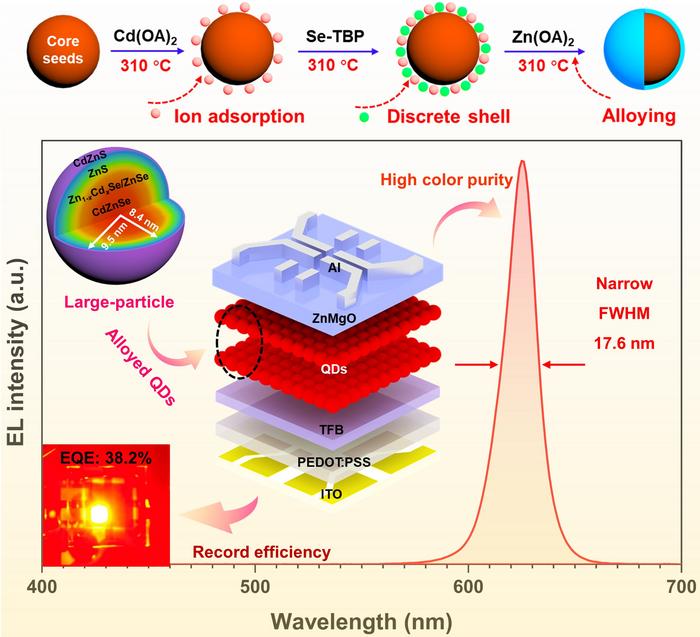
Quantum Dot Light Emitting Diodes (QLEDs) have steadily emerged as front-runners in the realm of optoelectronic applications, especially in high-end display technology. A recent breakthrough from a collaboration between Soochow University and Macau University of Science and Technology has pushed the boundaries of this area even further. This advancement revolves around the development of tailored, high-color-purity red quantum dots (QDs) that possess remarkable efficiency, stability, and brightness. These innovations are poised to redefine expectations for future display devices, particularly with respect to their performance in ultra-high-definition applications.
The research team’s approach employed a sophisticated method known as high-temperature successive ion layer adsorption and reaction (HT-SILAR). By utilizing this technique, researchers have synthesized a new class of gradient alloyed quantum dots that offer significant improvements in luminescent properties. The tailored QDs composed of a composite structure of CdZnSe/Zn₁₋ₓCdₓSe/ZnSe/ZnS/CdZnS exhibit an impressive ultra-narrow emission full width at half maximum (FWHM) of just 17.1 nm. This characteristic is remarkable and contributes significantly to the high color purity of the emitted light.
The photoluminescence quantum yield (PLQY) of these QDs is near unity, indicating that they can convert nearly all absorbed light into emitted light with minimal losses. As a result, the external quantum efficiency (EQE) of the red QLEDs reached a record-breaking 38.2%. This exceptional efficiency suggests that not only can these devices output brilliant color, but they can also do so while consuming less power, a vital characteristic for sustainable technology.
Furthermore, the operational lifetime of the devices tested at a luminance level of 1,000 cd/m² exceeds 24,100 hours. This impressive stability ensures that these QLEDs can maintain top performance for extended periods, making them a reliable choice for consumers. To put this into perspective, if these devices are utilized for eight hours per day, they could last for up to eight years without significant degradation in performance. The ability to sustain long-term brightness and efficiency is a game-changer for manufacturers and end-users alike.
The synthesis process involved meticulous control over the thickness of the Zn₁₋ₓCdₓSe/ZnSe shells, which effectively alleviates compressive strain within the quantum dots. This strain reduction is crucial, as it prevents the heavy-hole energy band splitting and weakens exciton-phonon coupling—two phenomena that negatively impact luminescence. By mastering this control, the researchers have made strides in enhancing the quality and performance of the QDs.
Another critical aspect of the research is the design of the shell layers. The advanced configuration of the Zn₁₋ₓCdₓSe/ZnSe/ZnS shells confines electronic carriers within the core of the quantum dots. This design tweak enhances the efficiency of light emission by boosting PLQY. In addition, the incorporation of Cd-doped ZnS shells acts to passivate surface defects, facilitating smooth hole injection and achieving balanced carrier recombination. This control translates into devices that do not merely operate effectively on paper but exhibit real-world performance improvements and stability.
Further findings reveal that the use of large-size quantum dots significantly reduces heat generation in the QLED devices. This is an essential factor since excessive heat can lead to detrimental effects, such as screen burn-in, which affects image quality and longevity. By mitigating this risk, the research team has also addressed a common issue in existing display technologies, thus bolstering user satisfaction and device reliability.
As investigations into these novel QDs continue, they serve as a foundation for the advancement of display technologies designed to meet high consumer expectations. The breakthrough is not only significant for devices like televisions and monitors but also sets the stage for more sophisticated applications in various fields, including medical imaging and advanced lighting solutions. As manufacturers look for greener and more tech-savvy ways to provide vibrant displays, these findings hold great promise for the future of the industry.
The research was published in the peer-reviewed journal “Science Bulletin,” highlighting its significance in the scientific community. The findings and techniques outlined in the publication are expected to attract considerable attention from both academia and industry sectors alike, as they pave the way for next-generation optoelectronic devices.
Moreover, the collaborative nature of this research unites institutions known for their expertise in materials science and engineering, further enhancing the credibility and reach of the study. The results showcase the importance of interdisciplinary approaches to tackle complex scientific challenges.
With the groundbreaking results and the potential impact of these large-particle quantum dots on the QLED landscape, this study opens exciting avenues for future exploration. As QLED technology continues to evolve, it is crucial to monitor further developments in quantum dot synthesis and device architecture that could result in even greater efficiencies and capabilities.
In conclusion, the advancements made by the Soochow University and Macau University of Science and Technology demonstrate significant strides in quantum dot technology that can bring forth innovations in both consumer electronics and material science sectors. The implications of this research stretch far beyond the confines of academia, promising a bright future for display technologies that harness the true potential of quantum dots.
Subject of Research: Quantum Dot Light Emitting Diodes
Article Title: Advancements in Quantum Dot Technology Enhancing QLED Performance
News Publication Date: October 2023
Web References: Science Bulletin DOI
References: Science Bulletin, Soochow University Research
Image Credits: ©Science China Press
Keywords
Quantum dots, QLEDs, photoluminescence, external quantum efficiency, stability, display technology, high-temperature successive ion layer adsorption and reaction, materials science, optoelectronics, luminescent materials, quantum efficiency, surface defects.
Tags: Display Performance InnovationsExternal Quantum EfficiencyGradient Alloyed Quantum DotsHigh-Color-Purity Quantum DotsHigh-Temperature Successive Ion Layer AdsorptionLuminescent Properties ImprovementOptoelectronic ApplicationsPhotoluminescence Quantum YieldQLED Display AdvancementsQuantum Dot TechnologyTailored Quantum Dot StructuresUltra-High-Definition Displays





